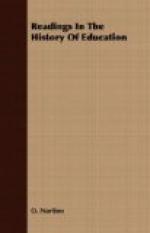2. THE NEW METHOD
The new method of study and investigation, developed by Abelard, was a second influence of importance in the growth of universities. The method itself—later known as the scholastic method—is illustrated on pages 20, 58, 121 ff. The present section therefore merely indicates the ways in which it influenced the course of higher education.
(a) The new method was one cause of the awakened interest in study and investigation. Its effect is thus described by the most learned historian of mediaeval universities:
Paris and Bologna experienced before all other schools, and nearly simultaneously, at the beginning of the twelfth century, an unexpected, almost sudden development. For in these schools alone a definite branch of learning was treated ... by a new method, adapted to contemporary needs, but hitherto unknown, or insufficiently known, to other teachers of the period; and thereby a new era of scientific investigation was inaugurated. This new method had an attractive power for teachers and scholars of various countries ... In this way the cornerstones of permanent abodes of learning were laid. The continually growing number of scholars brought with it the increase of teachers; the desire of both classes for learning was awakened; and this desire, and the combative exchange of ideas in the disputations,—which now first became really established in the schools as a result of the new method,—were effective forces to keep investigation active, and the schools themselves from decline.
In Paris, it was the cultivation of Logic, but chiefly the new method in Theology, ... developed in various ways especially by Abelard and other teachers, and extended by his contemporaries and their disciples ... which caused the revolution in the schools of that city.[16]
(b) The new method of Abelard established a new form of exposition, and consequently a new mode of teaching, in Canon Law and in Theology. The earliest university text-book in Canon Law—the “Decretum” of Gratian—adopted this method, with some modifications. It was followed in portions of the chief text-book in Theology,—the “Sentences” of Peter Lombard. Variously modified, it became the method used in all subsequent scholastic philosophy and theology. It was widely used in connection with other university studies. In general, it was to mediaeval education what the method of experiment is to the study and teaching of modern natural science. A good illustration of its recent use is Thomas Harper’s “Metaphysic of the School.”
(c) The scholastic method became the basis of one of the most important university exercises,—the disputation or debate, which was employed in every field of study.[17]
3. THE NEW STUDIES




